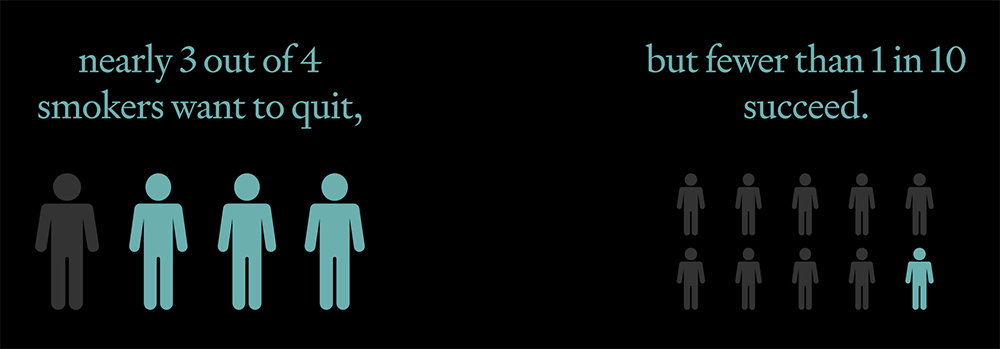What are reduced
nicotine cigarettes?
Reduced nicotine cigarettes are made with proprietary tobacco developed by leading plant scientists using a range of modern breeding techniques. This tobacco contains minimally or non-addictive levels of nicotine. Studies funded by the FDA, U.S. National institute on Drug Abuse (NIDA), and others have found that reducing nicotine to minimal or non-addictive levels can lead to: a reduction in the number cigarettes smoked per day, an increased number of smoke-free days, and double the number of quit attempts, all with minimal evidence of withdrawal symptoms.1
Why focus on nicotine?
While nicotine is not what makes cigarettes toxic, it is a highly addictive chemical compound present in tobacco plants. Addiction to nicotine in combusted products is the main driver of chronic and compulsive use of tobacco products at large, including cigarettes. In announcing its proposal, the FDA stated the goal of its proposed reduced nicotine rule would be "to reduce youth use, addiction and death."
Smoking remains the leading cause of preventable death. In the U.S.,

What research
has been done?
Reduced nicotine cigarettes have been the subject of research for over a decade. The U.S. federal government has invested over $100 million for more than 50 independent clinical trials. The research was conducted by or for esteemed public health institutions and universities. For example, Johns Hopkins University, the Mayo Clinic, MD Anderson Cancer Center, and the University of Pittsburgh among others have participated in this research.
A paper published by the FDA in the New England Journal of Medicine in 2018 projected that by year 2100, a nicotine product standard could result in more than 33 million people never becoming regular smokers, a smoking rate of only 1.4%, and more than 8 million fewer people dying from tobacco-related illnesses. An introduction of this regulation would be a paradigm shift for the public health of the United States.
According to the CDC,
smoking costs the U.S. economy
$1,000,000,000
every three years in direct medical care for adults and lost productivity due to premature death and exposure to secondhand smoke.
Significant Clinical Trials
The Effects of Immediate vs Gradual Reduction in Nicotine Content of Cigarettes on Smoking Behavior: An Ecological Momentary Assessment Study
"The significantly lower cravings were observed in the immediate vs. gradual nicotine reduction group, and led to faster reduction in the number of CPD, and a significant increase in the number of cigarette-free days. These findings add to the evidence base for reduced nicotine content in cigarettes."
Read MoreEffects of Immediate vs Gradual Reduction in Nicotine Content of Cigarettes on Biomarkers of Smoke Exposure
"Among smokers, immediate reduction of nicotine in cigarettes led to significantly greater decreases in biomarkers of smoke exposure across time compared with gradual reduction or a control group, with no significant differences between gradual reduction and control."
Read MoreRandomized Trial of Reduced-Nicotine Standards for Cigarettes
"Cigarettes with lower nicotine content, as compared with control cigarettes, reduced exposure to and dependence on nicotine, as well as cravings during abstinence from smoking, without significantly increasing the expired carbon monoxide level or total puff volume, suggesting minimal compensation."
Read MorePotential Public Health Effects of Reducing Nicotine Levels in Cigarettes in the United States
"Our model indicates that enacting a regulation to lower the nicotine content of cigarettes to minimally addictive levels in the United States would lead to a substantial reduction in tobacco-related mortality, despite uncertainty about the precise magnitude of the effects on smoking behaviors."
Read MoreDo the studies consider minorities and vulnerable groups?
Yes! A number of studies have specifically investigated reduced nicotine content cigarettes in minority communities and vulnerable groups. For example, a study by the University of Vermont Center on Tobacco Regulatory Science, led by Higgins et al, explored whether reduced nicotine cigarettes affected especially vulnerable populations. Study participants included economically disadvantaged women of reproductive age, opioid-dependent individuals, and individuals with affective disorders. The results showed that reduced nicotine cigarettes did not show evidence of compensatory smoking. In fact, study participants that smoked reduced nicotine cigarettes showed significant reductions in nicotine withdrawal and cravings.
Are Reduced Nicotine Cigarettes Available in the U.S.?
Yes, the FDA authorized the marketing of tobacco products that help reduce exposure to and consumption of nicotine for smokers as modified risk tobacco products (MRTPs) in December 2021.
Learn MoreIn 2018, about 55% of adult smokers had made a quit attempt in the past year, but only about 8% were successful in quitting for 6-12 months. (Creamer, 2018)






